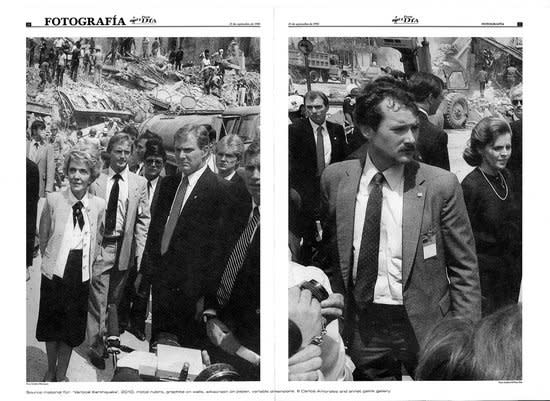Annet Gelink Gallery proudly presents Vertical Earthquake, the second solo exhibition of Carlos Amorales (Mexico D.F. 1970). In this installation Amorales refers to the 1985 earthquake in Mexico City which he witnessed at the age of fifteen. The earthquake was very important for Amorales in regard to his aesthetic development. Manifesting itself in two ways, emotionally deeply affected by the drama of the event he saw in the ruined buildings also the beauty of chaos and image fragmentation.
The latter is typical for Amorales' work in which the picture is often built from various fragments. The observer is hereby invited by the artist to assign an own meaning to the work. 'I don't create art that lectures or tells you what to think, instead my art helps you ponder, giving possibilities of what to think', says Amorales. The flow of criticism that after the earthquake followed the actions of the Mexican authorities laid the foundation for the political nature of Amorales' work. In his work he criticized the exploitation of cheap labor when he participated in the Dutch pavilion for the Venice Biennale in 2003 with a variation of a Mexican sweatshop (Flames Maquiladora, 2001-2002). For Origami Bomb (2003-2004) he used the propaganda strategy of the Mexican government to reach people with flyers distributed from the air.
For Vertical Earthquake, the wall paintings in the gallery were made with the tools hanging on the walls - rulers in various forms derived from the fault lines in the ruined buildings. In the middle of the room, on two white tables, newspapers contain photos of the ruined buildings on which drawings of the fault lines have been made, the articles consist of anarchist texts from both famous and unknown writers.
Discarded spider, (2008) a16mm film transferred to video shows large-scale spiderwebs of malleable aluminim being transformed by the artist, adding texture to the otherwise flat image. His dark silhouette against the netting makes it look as though the artist is trapped in the gossamer.
Beside the installation there are paintings and collages on display. The images appearing in the collages originate from his 'Liquid Archive', a database of pictures to which Amorales adds pictures produced by himself and from the media. Before admitting the pictures to the 'Liquid Archive' Amorales abstracts areas of the image with blocks of colour. The re-appearing images in the 'Liquid Archive' are taken by Amorales from their original context and united in new and unusual combinations.

